Formula NaOH Density 2.13 g/cm³ Melting point 318 °C | Molar mass 39.997 g/mol Boiling point 1,388 °C Soluble in Water, Methanol, Ethanol | |
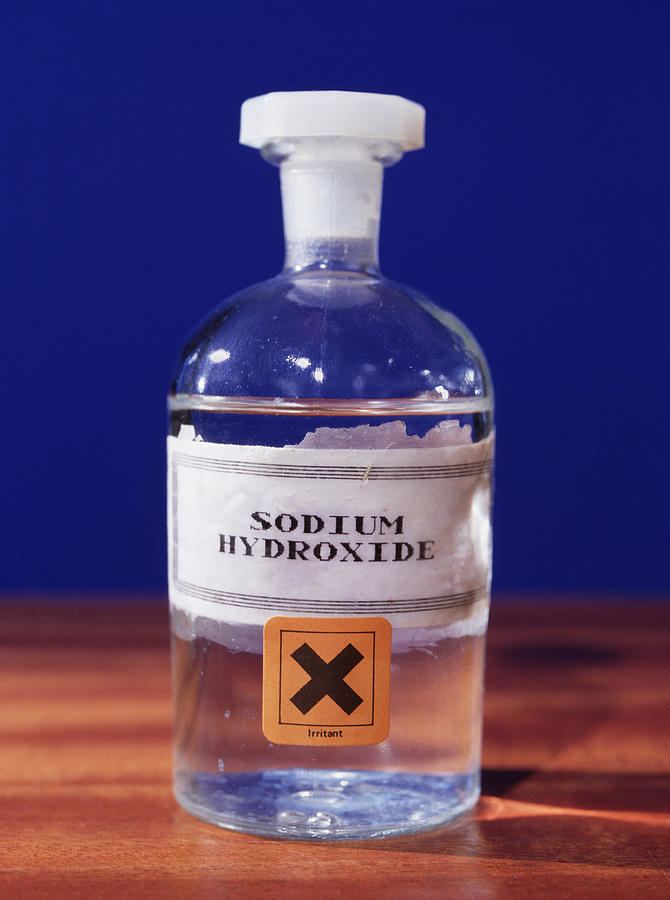 | ||
Appearance White, waxy, opaque crystals IUPAC ID Sodium oxidanide, Sodium hydroxide | ||
Sodium hydroxide (NaOH), also known as lye and caustic soda, is an inorganic compound. It is a white solid and highly caustic metallic base and alkali of sodium which is available in pellets, flakes, granules, and as prepared solutions at different concentrations. Sodium hydroxide forms an approximately 50% (by mass) saturated solution with water.
Contents
- Sodium hydroxide naoh 3d ionic compound
- Physical properties
- Reaction with acids
- Reaction with acidic oxides
- Reaction with amphoteric metals and oxides
- Precipitant
- Saponification
- Production
- Uses
- Chemical pulping
- Tissue digestion
- Dissolving amphoteric metals and compounds
- Esterification and transesterification reagent
- Food preparation
- Cleaning agent
- Water treatment
- Historical uses
- In Cement mixes mortars concrete grouts
- Flavonoids
- Summer winter heat storage
- Safety
- History
- Commercial brands
- References

Sodium hydroxide is soluble in water, ethanol, and methanol. This alkali is deliquescent and readily absorbs moisture and carbon dioxide in air.

Sodium hydroxide is used in many industries, mostly as a strong chemical base in the manufacture of pulp and paper, textiles, drinking water, soaps and detergents and as a drain cleaner. Worldwide production in 2004 was approximately 60 million tonnes, while demand was 51 million tonnes.
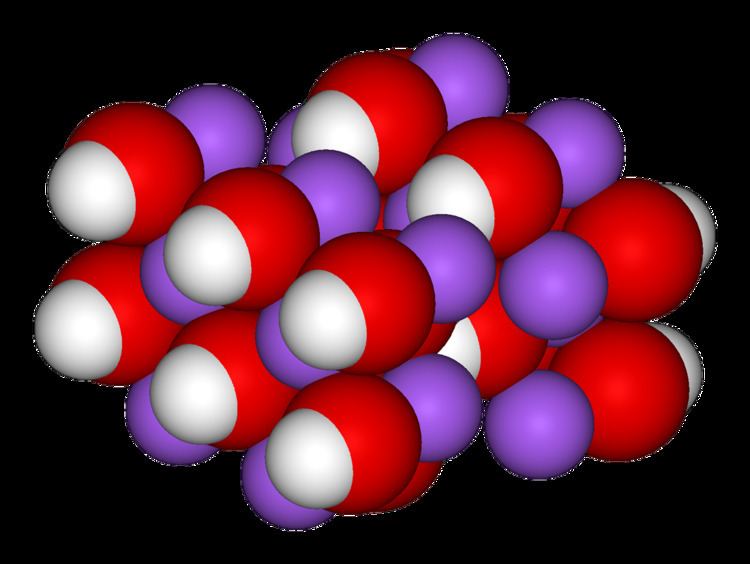
Sodium hydroxide naoh 3d ionic compound
Physical properties
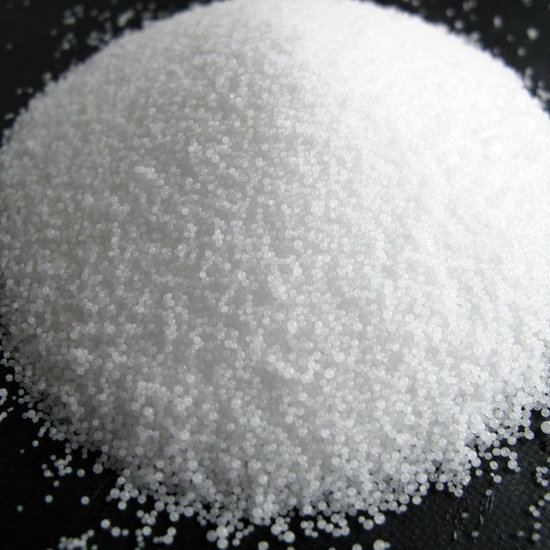
Pure sodium hydroxide is a whitish solid, sold in pellets, flakes, and granular form, as well as in solution. It is highly soluble in water, with a lower solubility in ethanol and methanol, but is insoluble in ether and other non-polar solvents.
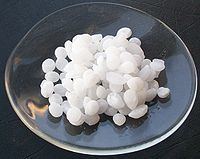
Similar to the hydration of sulfuric acid, dissolution of solid sodium hydroxide in water is a highly exothermic reaction in which a large amount of heat is liberated, posing a threat to safety through the possibility of splashing. The resulting solution is usually colourless and odorless. As with other alkaline solutions, it feels slippery when it comes in contact with skin.
Reaction with acids

Sodium hydroxide reacts with protic acids to produce water and the corresponding salts. For example, when sodium hydroxide reacts with hydrochloric acid, sodium chloride is formed:
NaOH(aq) + HCl(aq) → NaCl(aq) + H2O(l)In general, such neutralization reactions are represented by one simple net ionic equation:
OH−(aq) + H+(aq) → H2O(l)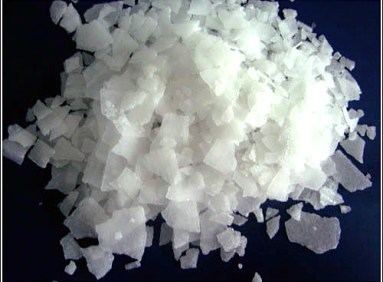
This type of reaction with a strong acid releases heat, and hence is exothermic. Such acid-base reactions can also be used for titrations. However, sodium hydroxide is not used as a primary standard because it is hygroscopic and absorbs carbon dioxide from air.
Reaction with acidic oxides
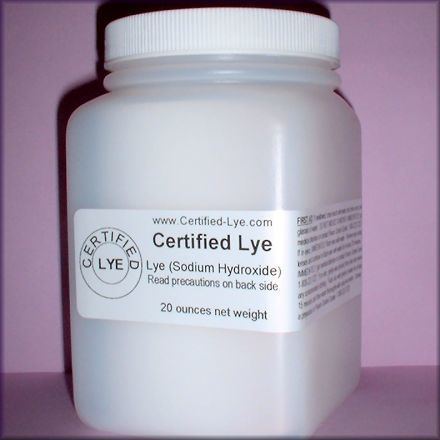
Sodium hydroxide also reacts with acidic oxides, such as sulfur dioxide. Such reactions are often used to "scrub" harmful acidic gases (like SO2 and H2S) produced in the burning of coal and thus prevent their release into the atmosphere. For example,
2 NaOH + SO2 → Na2SO3 + H2OReaction with amphoteric metals and oxides
Glass reacts slowly with aqueous sodium hydroxide solutions at ambient temperatures to form soluble silicates. Because of this, glass joints and stopcocks exposed to sodium hydroxide have a tendency to "freeze". Flasks and glass-lined chemical reactors are damaged by long exposure to hot sodium hydroxide, which also frosts the glass. Sodium hydroxide does not attack iron since iron does not have amphoteric properties (i.e., it only dissolves in acid, not base). A few transition metals, however, may react vigorously with sodium hydroxide.
In 1986, an aluminium road tanker in the UK was mistakenly used to transport 25% sodium hydroxide solution, causing pressurization of the contents and damage to the tanker. The pressurization was due to the hydrogen gas which is produced in the reaction between sodium hydroxide and aluminium:
2 Al + 2 NaOH + 6 H2O → 2 NaAl(OH)4 + 3 H2Precipitant
Unlike sodium hydroxide, the hydroxides of most transition metals are insoluble, and therefore sodium hydroxide can be used to precipitate transition metal hydroxides. The following colours are observed: blue-copper, green-iron(II), yellow/brown-iron(III). Zinc and lead salts dissolve in excess sodium hydroxide to give a clear solution of Na2ZnO2 or Na2PbO2.
Aluminium hydroxide is used as a gelatinous flocculant to filter out particulate matter in water treatment. Aluminium hydroxide is prepared at the treatment plant from aluminium sulfate by reacting it with sodium hydroxide or bicarbonate.
Al2(SO4)3 + 6 NaOH → 2 Al(OH)3 + 3 Na2SO4Al2(SO4)3 + 6 NaHCO3 → 2 Al(OH)3 + 3 Na2SO4 + 6 CO2Saponification
Sodium hydroxide can be used for the base-driven hydrolysis of esters (as in saponification), amides and alkyl halides. However, the limited solubility of sodium hydroxide in organic solvents means that the more soluble potassium hydroxide (KOH) is often preferred. Touching sodium hydroxide solution with the bare hands, while not recommended, produces a slippery feeling. This happens because the oils of the hand are converted to soap.
Production
Sodium hydroxide is industrially produced as a 50% solution by variations of the electrolytic chloralkali process. Chlorine gas is also produced in this process. Solid sodium hydroxide is obtained from this solution by the evaporation of water. Solid sodium hydroxide is most commonly sold as flakes, prills, and cast blocks.
In 2004, world production was estimated at 60 million dry metric tonnes of sodium hydroxide, and demand was estimated at 51 million tonnes. In 1998, total world production was around 45 million tonnes. North America and Asia each contributed around 14 million tonnes, while Europe produced around 10 million tonnes. In the United States, the major producer of sodium hydroxide is the Dow Chemical Company, which has annual production around 3.7 million tonnes from sites at Freeport, Texas, and Plaquemine, Louisiana. Other major US producers include Oxychem, PPG, Olin, Pioneer Companies, Inc. (PIONA, which was purchased by Olin), and Formosa. All of these companies use the chloralkali process.
Historically, sodium hydroxide was produced by treating sodium carbonate with calcium hydroxide in a metathesis reaction. (Sodium hydroxide is soluble while calcium carbonate is not.) This process was called causticizing.
Ca(OH)2(aq) + Na2CO3(s) → CaCO3 ↓ + 2 NaOH(aq)This process was superseded by the Solvay process in the late 19th century, which was in turn supplanted by the chloralkali process which we use today.
Sodium hydroxide is also produced by combining pure sodium metal with water. The byproducts are hydrogen gas and heat, often resulting in a flame, making this a common demonstration of the reactivity of alkali metals in academic environments; however, it is not commercially viable, as the isolation of sodium metal is typically performed by reduction or electrolysis of sodium compounds including sodium hydroxide.
For further information in historical production, see alkali manufacture.Uses
Sodium hydroxide is a popular strong base used in industry. Around 56% of sodium hydroxide produced is used by industry, 25% of which is used in the paper industry. Sodium hydroxide is also used in the manufacture of sodium salts and detergents, pH regulation, and organic synthesis. It is used in the Bayer process of aluminium production. In bulk, it is most often handled as an aqueous solution, since solutions are cheaper and easier to handle.
Sodium hydroxide is used in many scenarios where it is desirable to increase the alkalinity of a mixture, or to neutralize acids.
For example, in the petroleum industry, sodium hydroxide is used as an additive in drilling mud to increase alkalinity in bentonite mud systems, to increase the mud viscosity, and to neutralize any acid gas (such as hydrogen sulfide and carbon dioxide) which may be encountered in the geological formation as drilling progresses.
Poor quality crude oil can be treated with sodium hydroxide to remove sulfurous impurities in a process known as caustic washing. As above, sodium hydroxide reacts with weak acids such as hydrogen sulfide and mercaptans to yield non-volatile sodium salts, which can be removed. The waste which is formed is toxic and difficult to deal with, and the process is banned in many countries because of this. In 2006, Trafigura used the process and then dumped the waste in Africa.
Chemical pulping
Sodium hydroxide is also widely used in pulping of wood for making paper or regenerated fibers. Along with sodium sulfide, sodium hydroxide is a key component of the white liquor solution used to separate lignin from cellulose fibers in the kraft process. It also plays a key role in several later stages of the process of bleaching the brown pulp resulting from the pulping process. These stages include oxygen delignification, oxidative extraction, and simple extraction, all of which require a strong alkaline environment with a pH > 10.5 at the end of the stages.
Tissue digestion
In a similar fashion, sodium hydroxide is used to digest tissues, as in a process that was used with farm animals at one time. This process involved placing a carcass into a sealed chamber, then adding a mixture of sodium hydroxide and water (which breaks the chemical bonds that keep the flesh intact). This eventually turns the body into a liquid with coffee-like appearance, and the only solid that remains are bone hulls, which could be crushed between one's fingertips. Sodium hydroxide is frequently used in the process of decomposing roadkill dumped in landfills by animal disposal contractors. Due to its low cost and availability, it has been used to dispose of corpses by criminals. Italian serial killer Leonarda Cianciulli used this chemical to turn dead bodies into soap. In Mexico, a man who worked for drug cartels admitted disposing of over 300 bodies with it. Sodium hydroxide is a dangerous chemical due to its ability to hydrolyze protein. If a dilute solution is spilled on the skin, burns may result if the area is not washed thoroughly and for several minutes with running water. Splashes in the eye can be more serious and can lead to blindness. This danger is often overlooked.
Dissolving amphoteric metals and compounds
Strong bases attack aluminium. Sodium hydroxide reacts with aluminium and water to release hydrogen gas. The aluminium takes the oxygen atom from sodium hydroxide, which in turn takes the oxygen atom from the water, and releases the two hydrogen atoms, The reaction thus produces hydrogen gas and sodium aluminate. In this reaction, sodium hydroxide acts as an agent to make the solution alkaline, which aluminium can dissolve in. This reaction can be useful in etching, removing anodizing, or converting a polished surface to a satin-like finish, but without further passivation such as anodizing or alodining the surface may become degraded, either under normal use or in severe atmospheric conditions.
In the Bayer process, sodium hydroxide is used in the refining of alumina containing ores (bauxite) to produce alumina (aluminium oxide) which is the raw material used to produce aluminium metal via the electrolytic Hall-Héroult process. Since the alumina is amphoteric, it dissolves in the sodium hydroxide, leaving impurities less soluble at high pH such as iron oxides behind in the form of a highly alkaline red mud.
Other amphoteric metals are zinc and lead which dissolve in concentrated sodium hydroxide solutions to give sodium zincate and sodium plumbate respectively.
Esterification and transesterification reagent
Sodium hydroxide is traditionally used in soap making (cold process soap, saponification). It was made in the nineteenth century for a hard surface rather than liquid product because it was easier to store and transport.
For the manufacture of biodiesel, sodium hydroxide is used as a catalyst for the transesterification of methanol and triglycerides. This only works with anhydrous sodium hydroxide, because combined with water the fat would turn into soap, which would be tainted with methanol. NaOH is used more often than potassium hydroxide because it is cheaper and a smaller quantity is needed.
Food preparation
Food uses of sodium hydroxide include washing or chemical peeling of fruits and vegetables, chocolate and cocoa processing, caramel coloring production, poultry scalding, soft drink processing, and thickening ice cream. Olives are often soaked in sodium hydroxide for softening; Pretzels and German lye rolls are glazed with a sodium hydroxide solution before baking to make them crisp. Owing to the difficulty in obtaining food grade sodium hydroxide in small quantities for home use, sodium carbonate is often used in place of sodium hydroxide.
Specific foods processed with sodium hydroxide include:
Cleaning agent
Sodium hydroxide is frequently used as an industrial cleaning agent where it is often called "caustic". It is added to water, heated, and then used to clean process equipment, storage tanks, etc. It can dissolve grease, oils, fats and protein-based deposits. It is also used for cleaning waste discharge pipes under sinks and drains in domestic properties. Surfactants can be added to the sodium hydroxide solution in order to stabilize dissolved substances and thus prevent redeposition. A sodium hydroxide soak solution is used as a powerful degreaser on stainless steel and glass bakeware. It is also a common ingredient in oven cleaners.
A common use of sodium hydroxide is in the production of parts washer detergents. Parts washer detergents based on sodium hydroxide are some of the most aggressive parts washer cleaning chemicals. The sodium hydroxide-based detergents include surfactants, rust inhibitors and defoamers. A parts washer heats water and the detergent in a closed cabinet and then sprays the heated sodium hydroxide and hot water at pressure against dirty parts for degreasing applications. Sodium hydroxide used in this manner replaced many solvent-based systems in the early 1990s when trichloroethane was outlawed by the Montreal Protocol. Water and sodium hydroxide detergent-based parts washers are considered to be an environmental improvement over the solvent-based cleaning methods.
Sodium hydroxide is used in the home as a type of drain opener to unblock clogged drains, usually in the form of a dry crystal or as a thick liquid gel. The alkali dissolves greases to produce water soluble products. It also hydrolyzes the proteins such as those found in hair which may block water pipes. These reactions are sped by the heat generated when sodium hydroxide and the other chemical components of the cleaner dissolve in water. Such alkaline drain cleaners and their acidic versions are highly corrosive and should be handled with great caution.
Sodium hydroxide is used in some relaxers to straighten hair. However, because of the high incidence and intensity of chemical burns, manufacturers of chemical relaxers use other alkaline chemicals in preparations available to average consumers. Sodium hydroxide relaxers are still available, but they are used mostly by professionals.
A solution of sodium hydroxide in water was traditionally used as the most common paint stripper on wooden objects. Its use has become less common, because it can damage the wood surface, raising the grain and staining the colour.
Water treatment
Sodium hydroxide is sometimes used during water purification to raise the pH of water supplies. Increased pH makes the water less corrosive to plumbing and reduces the amount of lead, copper and other toxic metals that can dissolve into drinking water.
Historical uses
Sodium hydroxide has been used for detection of carbon monoxide poisoning, with blood samples of such patients turning to a vermilion color upon the addition of a few drops of sodium hydroxide. Today, carbon monoxide poisoning can be detected by CO oximetry.
In Cement mixes, mortars, concrete, grouts
Sodium hydroxide is used in some cement mix plasticisers. This helps Homogenise cement mixes, preventing segregation of sands and cement, decreases the amount of water required in a mix and increases workability of the cement product, be it mortar, render or concrete.
Flavonoids
See: Sodium hydroxide test for flavonoids
Summer -winter heat storage
EMPA researchers are experimenting with concentrated sodium hydroxide (NaOH) as the thermal storage or seasonal reservoir medium for domestic space-heating. If water is added to solid or concentrated sodium hydroxide (NaOH), heat is released. The dilution is exothermic - chemical energy is released in the form of heat. Conversely, by applying heat energy into a dilute sodium hydroxide solution the water will evaporate so that the solution become more concentrated and thus store the supplied heat as latent chemical energy.]
Safety
Like other corrosive acids and alkalis, drops of sodium hydroxide solutions can readily decompose proteins and lipids in living tissues via amide hydrolysis and ester hydrolysis, which consequently cause chemical burns and may induce permanent blindness upon contact with eyes. Solid alkali can also express its corrosive nature if there is water, such as water vapor. Thus, protective equipment, like rubber gloves, safety clothing and eye protection, should always be used when handling this chemical or its solutions. The standard first aid measures for alkali spills on the skin is, as for other corrosives, irrigation with large quantities of water. Washing is continued for at least ten to fifteen minutes.
Moreover, dissolution of sodium hydroxide is highly exothermic, and the resulting heat may cause heat burns or ignite flammables. It also produces heat when reacted with acids.
Sodium hydroxide is corrosive to several metals, like aluminium which reacts with the alkali to produce flammable hydrogen gas on contact:
2 Al + 6 NaOH → 3 H2 + 2 Na3AlO32 Al + 2 NaOH + 2 H2O → 3 H2 + 2 NaAlO22 Al + 2 NaOH + 6 H2O → 3 H2 + 2 NaAl(OH)4Sodium hydroxide is also mildly corrosive to glass, which can cause damage to glazing or cause ground glass joints to bind. Careful storage is needed.
History
Sodium hydroxide was first prepared by soap makers. A procedure for making sodium hydroxide appeared as part of a recipe for making soap in an Arab book of the late 13th century: Al-mukhtara` fi funun min al-suna` (Inventions from the Various Industrial Arts), which was compiled by al-Muzaffar Yusuf ibn `Umar ibn `Ali ibn Rasul (d. 1295), a king of Yemen. The recipe called for passing water repeatedly through a mixture of alkali (Arabic: al-qily, where qily is ash from saltwort plants, which are rich in sodium ; hence alkali was impure sodium carbonate) and quicklime (calcium oxide, CaO), whereby a solution of sodium hydroxide was obtained. European soap makers also followed this recipe. When in 1791 the French chemist and surgeon Nicolas Leblanc (1742–1806) patented a process for mass-producing sodium carbonate, natural "soda ash" (impure sodium carbonate that was obtained from the ashes of plants that are rich in sodium) was replaced by this artificial version. However, by the 20th century, the electrolysis of sodium chloride had become the primary method for producing sodium hydroxide.
